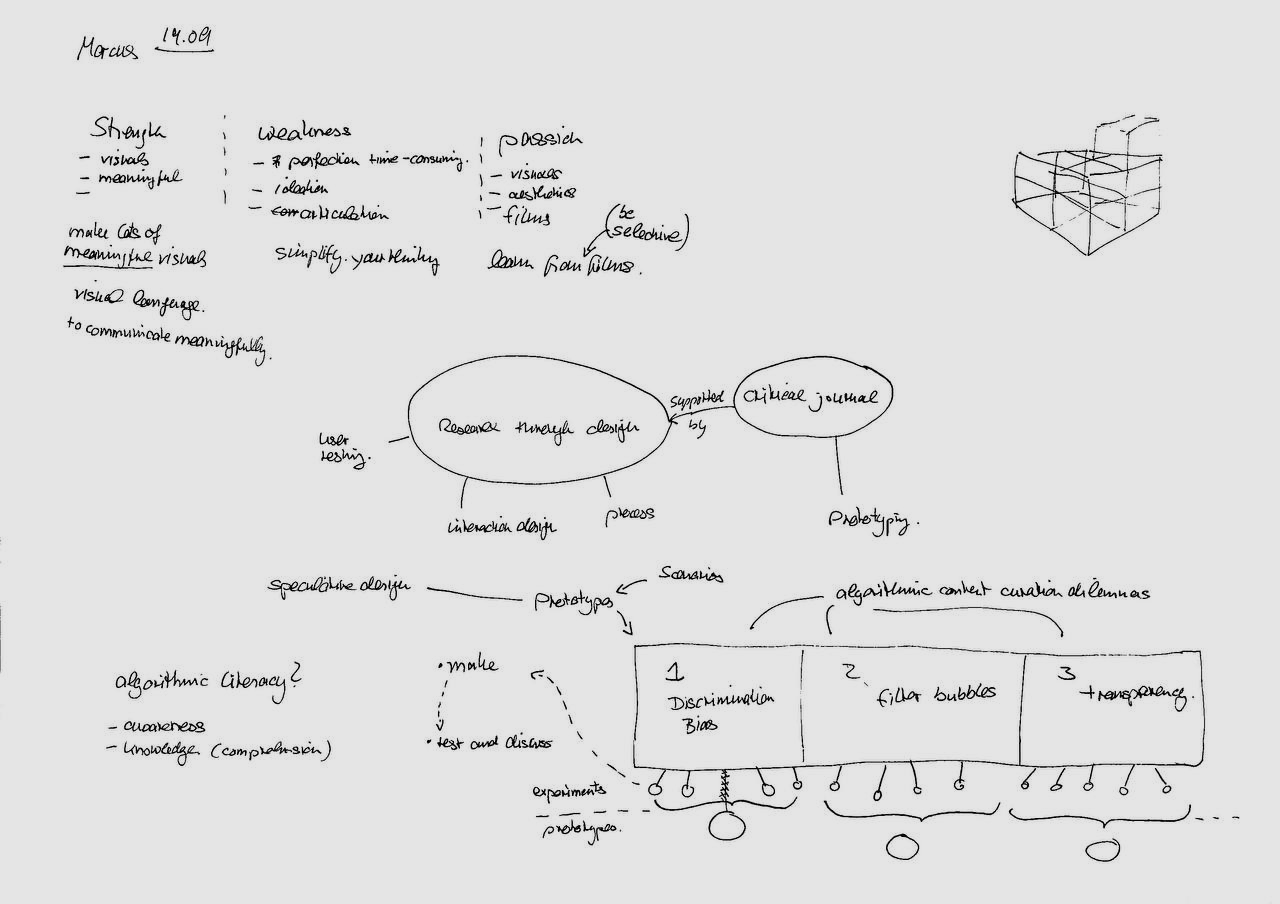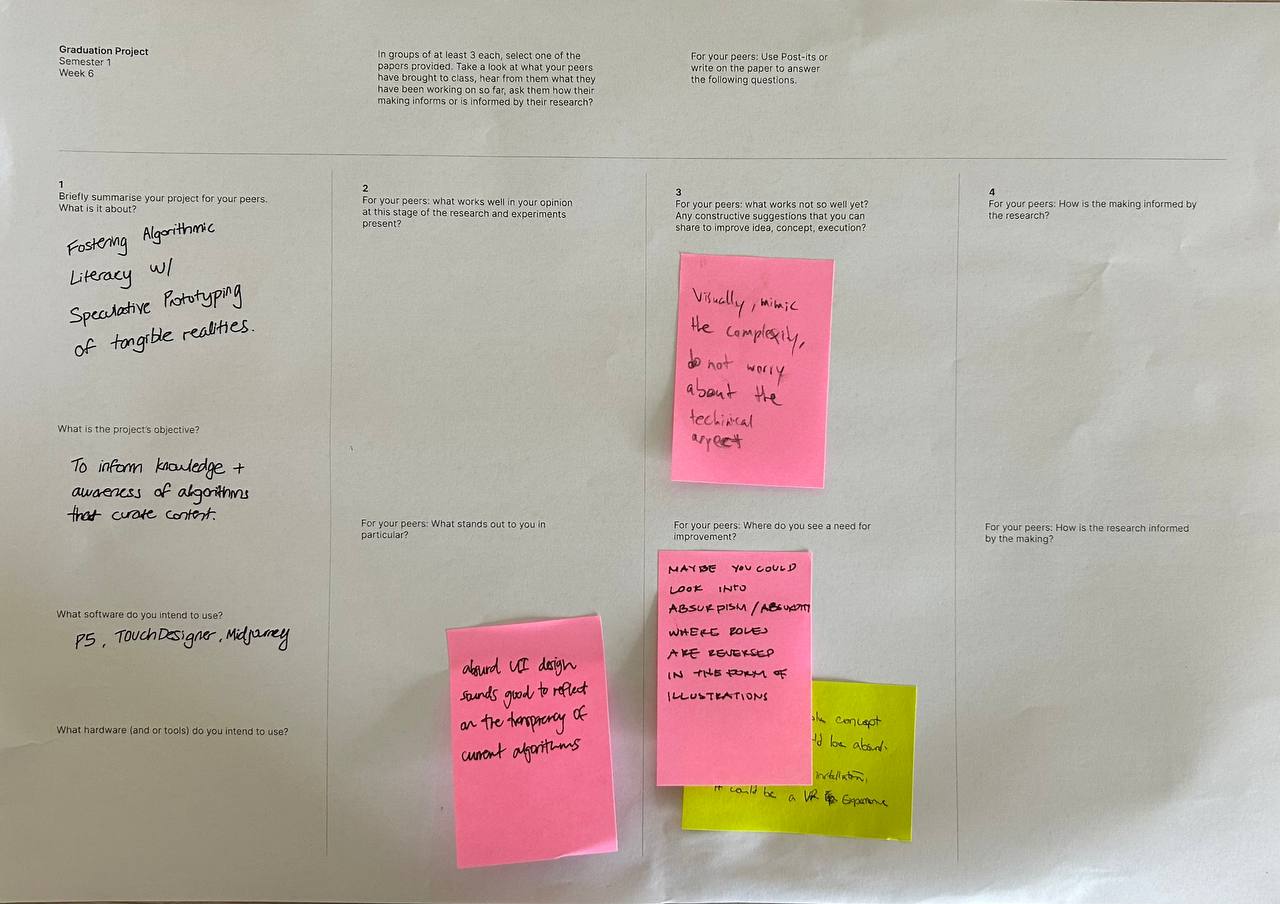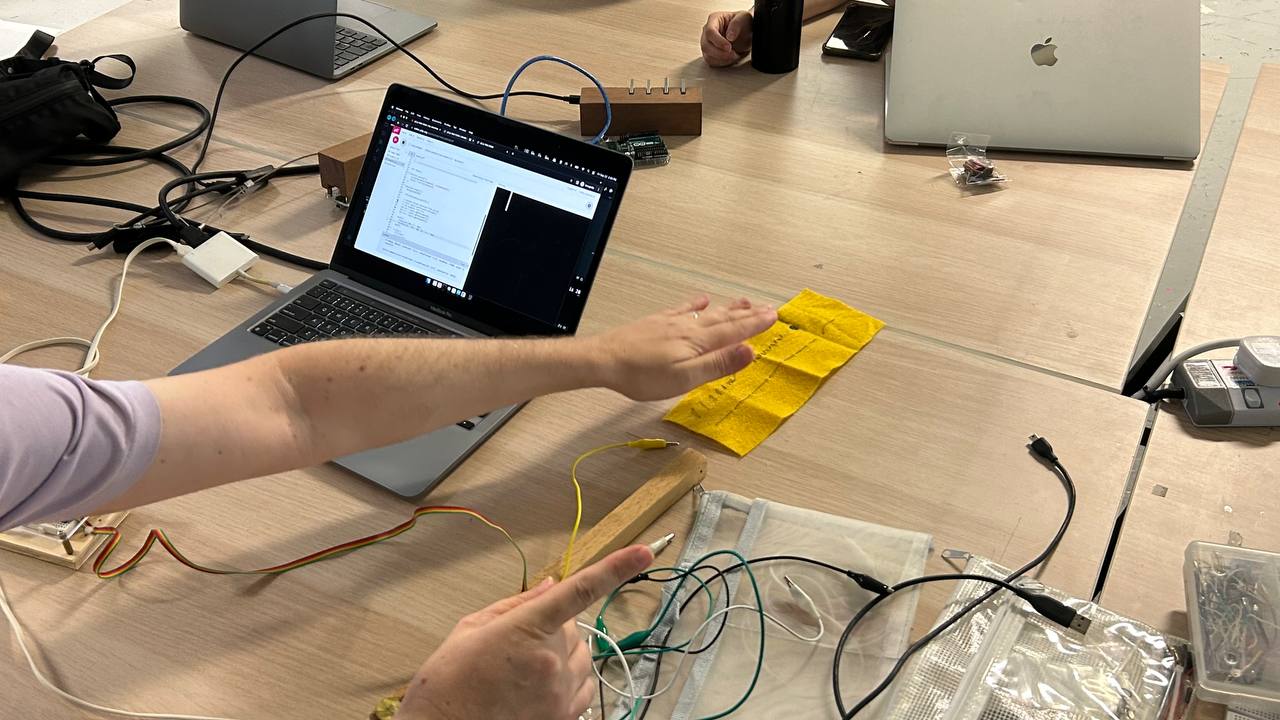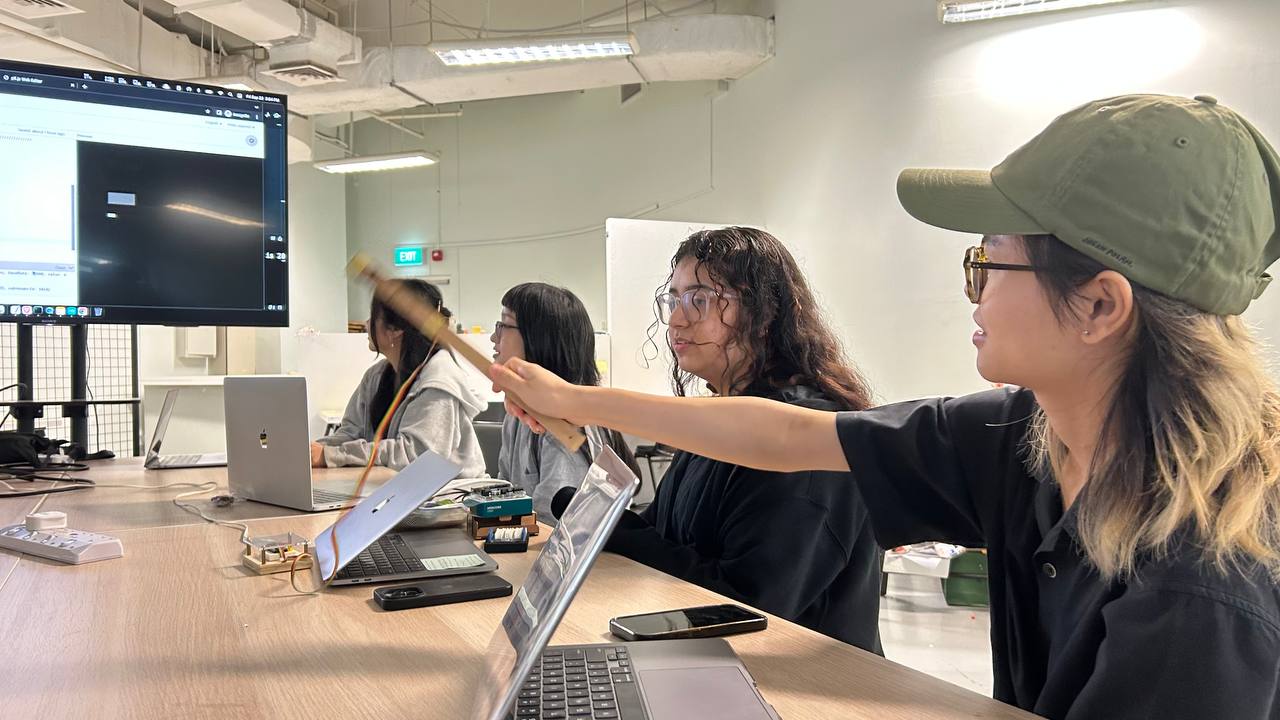▩▩▩▩▩▩▩ WEEK 6 ▩▩▩▩▩▩▩
Consultation
To be honest, the individual consultation with Andreas was much needed but also came at the right time. We touched the 3 main concerns I had, the framework of my RPO, concept of research through design (RtD), and the prototyping process. Andreas feedbacked that the methods in my RPO were too detailed and specific and wanted me to broaden my scope just for this section. I spent a lot of time working on that section just to make sure my research framework will be communicated clearly in my proposal. He also helped me to identify overthinking as one of my weaknesses and urged me to simplify my thoughts to improve articulation. As for my title, it still required a bit of work as I wanted to make sure I get all the key terms in my proposal first before applying it to my title. Furthermore, he proposed that I could maybe come up with a few research questions to aid me in my research objective, which I personally feel I can only do so after a little ideation for prototyping.

Andreas' notes
Research through Design (RtD)
Through this article that Andreas shared, I got to understand a little more about how to use the critical
journal for my research. RtD proves valuable for addressing two distinct yet interconnected sets of
questions, both of which are highly applicable to my research. The first set delves into the realm of
design itself, guiding the exploration of how to effectively design for future technologies and materials,
particularly those that are unfamiliar—a concept directly aligned with my investigation into the future
implications of algorithmic curation. The second set of questions centers around people: how individuals
will behave and think when engaging with these designs and how we can enhance their navigation—pertinent
to my objective of fostering algorithmic literacy.
Through the process of designing and interacting in RtD, I can gain insights and generate data. These
insights and data can then be analyzed and interpreted to draw conclusions and develop scientific
knowledge. This knowledge can include a deeper understanding of user behaviour, the impact of design
choices, or the effectiveness of certain design interventions.
In the context of my research on algorithmic content curation dilemmas, employing Research-through-Design
(RtD) allows me to gain valuable insights and collect data on how individuals interact with and respond to
different content curation approaches. This data can then be analysed and interpreted to draw conclusions
that contribute to the development of scientific knowledge in this field. Through RtD, I can gain greater
understanding of user behaviour concerning digital content consumption, assess the implications of various
design choices in addressing algorithmic curation challenges, and evaluate the effectiveness of these
design interventions. This iterative process of design, interaction, analysis, and knowledge development
will help to shape the foundation of my research methodology.

The Origin and Purpose of Research through Design - Mehmet Aydın Baytaş

Example of successful RtD project - Xerox Prototype Machines

Reference projects
Rethinking Prototype Concept -
Incorporating Visual Aesthetic
When I presented my prototype concepts, Andreas didn't seem particularly impressed. I had developed these
concepts based on what I believed would work, keeping them within the scope of my capabilities. It was
during this conversation that he helped me realize that I had overlooked a fundamental aspect of my design
passion – visual aesthetics.
To address this, Andreas guided me through a simple yet enlightening exercise aimed at identifying my
strengths, weaknesses, and true passions. This exercise provided the foundation for my prototype ideation.
Andreas suggested that I draw inspiration from one of my listed passions, specifically film. Despite my
initial uncertainty, I decided to embrace this suggestion and use it as a starting point for my ideation
process.
I'm genuinely grateful for this feedback because, at this stage, I was starting to worry that my research
might turn out to be lackluster. Considering that it informs my graduation project, I was concerned about
having insufficient material to work with down the line. I think this reminder to not compromise my
passion
really triggered me to think deeper about what I want to achieve and encouraged me to work towards it more
confidently.
To kickstart, I began by curating a moodboard featuring a selection of visuals I'm eager to explore. I
found
Instagram to be a more valuable resource for discovering moving images compared to Pinterest. The creators
on Instagram often include relevant hashtags, which not only aids in finding tutorials but also opens up
avenues to discover similar artworks. This approach has enabled me to study how various creators
incorporate
their unique styles into their works, providing inspiration for my own creative permutations. I also
looked
at some exhibitions with curated visual works to get inspiration for storytelling narratives.

#procedural

Moodboard Keywords: #particles #shaders #LiDar #audioreactive
AI Art, Artist & Machine Learning
During my exploration of AI Art and artists' engagement with machine learning, I came across a
thought-provoking YouTube video. In one segment, the video delves into the ethical dimensions surrounding
AI training methodologies. Of particular concern is the AI's ability to categorize and deduce an
individual's personality solely based on their appearance. This concern underscores a fundamental issue
rooted in the datasets we provide for machine learning algorithms.
The crux of the problem lies in the pursuit of greater accuracy in AI applications for commercial
purposes, often leading to unintended consequences and potential stereotyping. As we seek to enhance AI's
precision and efficiency, we may inadvertently overlook the ethical considerations and biases embedded
within the data we feed these algorithms. This oversight not only raises questions about the responsible
development and deployment of AI but also underscores the need for a critical examination of the ethical
dimensions surrounding AI training practices.
As I further investigate algorithmic content curation and its intricate dilemmas in my research, the
ethical implications of AI training methods, such as the one highlighted in the video, serve as a
pertinent reminder of the multifaceted challenges in this evolving digital landscape.

AI Art: How artists are using and confronting machine learning | HOW TO SEE LIKE A MACHINE - Museum of Modern Art (Youtube)
Feedback Session
The feedback session proved immensely valuable in identifying gaps and alleviating self-doubt regarding my
project. It allowed me to gain a fresh perspective on my work, with peers' questions illuminating areas
where my research needed refinement. Furthermore, their insights introduced new keywords that may lead to
intriguing avenues for further investigation.
During my presentation, I couldn't help but notice how the term 'absurd' resonated with my audience,
despite my mentioning it only briefly. It became evident that the notion of incorporating absurdity had a
profound impact on the listeners. This finding aligns with my readings on speculative design, which have
highlighted the effectiveness of absurdity in suspending the audience's disbelief.
Additionally, my peers displayed a keen interest in the concept of counterfactuals. When I presented an
example involving an alternate present based on the reversal of race during America's slavery era, and how
it would be reflected in algorithmic bias, they seemed to connect with the idea. Counterfactual scenarios,
it appears, evoke a unique blend of unfamiliarity and authenticity, providing an intriguing lens through
which to view complex issues.
Ryan and I delved into quite similar topics during our discussion. I found his approach particularly
intriguing, as he had devised a method to automate the extraction of data from tweets into an Excel sheet.
I had been contemplating various ways to work with data, but my ideas seemed rather labor-intensive in
comparison. Ryan not only demonstrated how he accomplished this but also provided valuable advice on
refining my search by using specific keywords. This guidance saved me from the daunting task of sifting
through an extensive volume of tweets to filter out irrelevant data.
During the peer-sharing session, I made a concerted effort to ask probing questions whenever my peers
presented their work. When faced with vague or uncertain responses, I opted for straightforwardness,
inquiring whether they were unsure or had not yet conducted research on a particular aspect. My intention
was to assist them in identifying areas where their research might be lacking. While I'm aware that such
directness can be misinterpreted, I was thankful to find that my peers understood my intentions behind it.

My feedbacks

Ryan sharing APIFY
Arduino Session
I decided to attend Andreas' Arduino session as a refresher, given that I had only dabbled in it during my first year in CiD, primarily with some straightforward projects. I also had a set of questions that I believed would be better addressed in person rather than through online searches.
I have two specific ideas I intend to explore using Arduino: a motion sensor and an eye tracker. During the session, Andreas demonstrated the use of a touchboard with conductors for the motion sensor and showcased the types of data and values we could extract using the kits. Interestingly, Andreas pointed out that Arduino might not be necessary for working with eye tracking and suggested several existing JavaScripts I could employ.
I find sessions like these immensely valuable as they help me explore my options and receive answers to my queries and doubts. When I conducted online searches such as 'Can Arduino...,' most results simply affirmed that it's possible without delving into whether it's the preferred method or providing alternative options. That's why sessions like this one save a significant amount of time and offer practical guidance.

Touchboard kit w/ fabric and thread

YiShan playing around with the Gyro sensor